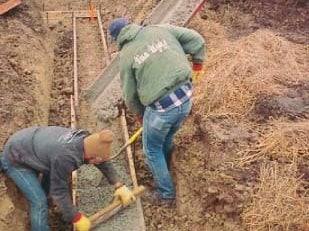- Concrete footings 101
- Bearing capacity of soil
Understanding soil type and bearing capacities - Footing size
How to determine the minimum size for soil conditions - Footing problems
Pouring in wet soil and more - Frost heave & foundation footings
- Frost protected shallow footings
- Related Information:
- Concrete calculator for footing pours:
Figure out how many cubic yards you'll need - Foundation drains for concrete footings
Concrete Footings - Building Footings for Foundations & More
Learn the role footings play in keeping foundations from settling and how to size them properly for soil conditionsFootings are an important part of foundation construction. They are typically made of concrete with rebar reinforcement that has been poured into an excavated trench. The purpose of footings is to support the foundation and prevent settling. Footings are especially important in areas with troublesome soils.
Find nearby slab and foundation contractors to help with your footings.
The construction of footings is best left to the pros that can assess the soil conditions and decide on the proper depth and width for the footings as well as the proper placement. The dimensions of footings also depend on the size and type of structure that will be built. Placement of footings is crucial to provide the proper support for the foundation and ultimately the structure.
Concrete footings may also be needed for projects such as a deck, pergola, retaining wall or other types of construction.
If you know your soil bearing capacity, following these practical guidelines will ensure strong footings.
What are Footings?
Under every house is a foundation, and under most foundations are footings. Most of the time we take footings for granted, and usually we can: For typical soils, a common 16- or 20-inch-wide footing can more than handle the relatively light weight of an ordinary house.
Common footing designs:
- Spread footing
Upside down “T” shape - Stepped footing
Stair-like design spreads out load - Trench footing
Shallow trench filled with concrete
On the other hand, if you build on soft clay soil or if there's a soft zone under part of your foundation, there can be trouble. A footing that performs well in good soil may not do so well in weak bearing conditions. We don't often see outright failure, but it's not uncommon to see excessive settlement when soil bearing capacity is low.
If the whole house settles slowly and evenly, some additional settlement is no big deal; but if settlement is uneven (differential settlement), there could be damage. A frame house with wood siding and drywall interiors can probably handle up to 1/2 an inch of differential foundation movement, but even 1/4 of an inch of uneven settling is enough to cause cracks in masonry, tile, or plaster.
Related: Foundation Repair
It's the unusual situations that cause the most trouble. When the footing is laid out off-center so the wall misses its bearing, when you encounter a soft zone on site, or when the footing is undersized, the builder faces a judgment call. If you think there's a problem ahead, you know you should stop and call an engineer. But if the risk is low, you'd like to keep the job moving.
In these tough cases, it's helpful to understand the bearing strength of soil and the reasons behind footing design rules. In very strong soils, minor mistakes probably aren't a big deal. In weak or marginal soils, however, it's best to be very cautious some of the solutions contractors think up may not really work.
I'm a consulting engineer as well as a contractor, and I get called in to a lot of problem situations. I find that people understand the problems better if they have some background knowledge. For the benefit of builders in the field and at the risk of oversimplifying, I'm going to use non-technical language in this article to briefly explain a little about how footings work and to present some ideas for dealing with special situations. As you look at the solutions I recommend, however, keep in mind that high-bearing-capacity soil is assumed. Any time you're in doubt about the soil under your foundation, you'd be wise to get professional help.
Brent Anderson is a consulting engineer and concrete contractor who serves on the American Concrete Institute Committee 332, Residential Concrete.










